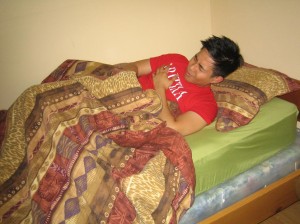Atopic dermatitis also known as eczema is a condition that makes the skin itchy and dry. This skin condition is quite common among children but it can also happen at any age. Atopic dermatitis can have asthma or hay fever and flares up regularly and eventually subsides.
Symptoms
- Red to brownish-gray patches can develop especially on the hands, ankles, wrist, feet, neck, eyelids, chest and upper chest as well as the face and scalp of an infant.
- Itching that becomes severe at night
- Thickened, dry, cracked and scaly skin
- Small, raised bumps that leaks out fluids and will crust over when scratched.
- Raw and sensitive swollen skin caused by scratching
Itching that becomes severe at night - Items that allow the buildup of dust such as feather pillows, mattresses, down comforters, carpeting and drapes can make the condition worse.
Causes
- A variation in the genes affecting the barrier function of the skin
- Dry, irritated skin
- Atopic dermatitis can be caused by bacteria such as staphylococcus aureus on the skin and develops a film that blocks the sweat glands
- Environmental conditions
Treatment
- Take the prescribed oral or anti-itch medications such as cetirizine or fexofenadine to lessen the severe itchiness. These medications should be taken before bedtime since they can drowsiness.
- Encourage the individual to take a bleach bath. Simply add ½ cup of household bleach to 40 gallons of water in a bathtub. Soak the body from the neck down or just the affected areas of the skin for at least 10 minutes. Avoid submerging the head. Rinse the affected area and pat dry and then moisturize. Take a bleach bath at least 2-4 times every week. Remember that a bleach bath helps lessen the amount of bacteria found in the skin and minimize the risk for infections.
- Apply an over-the-counter hydrocortisone cream that contains at least 1% hydrocortisone to lessen the itchiness. Apply this cream before moisturizing the skin.
- Apply moisturizers on the skin at least twice every day. It is recommended to apply moisturizers on the skin while it is still damp after a bath or shower. Apply the moisturizer especially on the arms, legs, back and the sides of the body. If the skin is dry, apply oil or lubricating cream.
- Avoid scratching the itchy area and wear gloves at night when sleeping in order to avoid scratching the affected area.
- Apply cool moist compress and cover the affected area using bandages and dressings to protect the skin from scratching.
- Take a warm bath and sprinkle baking soda, uncooked oatmeal or colloidal oatmeal into the bathtub that is filled with warm water. Soak the body for at least 10-15 minutes, pat dry and apply medicated lotions and a moisturizer.
- Use mild soaps but avoid those that contain dyes or perfumes.

